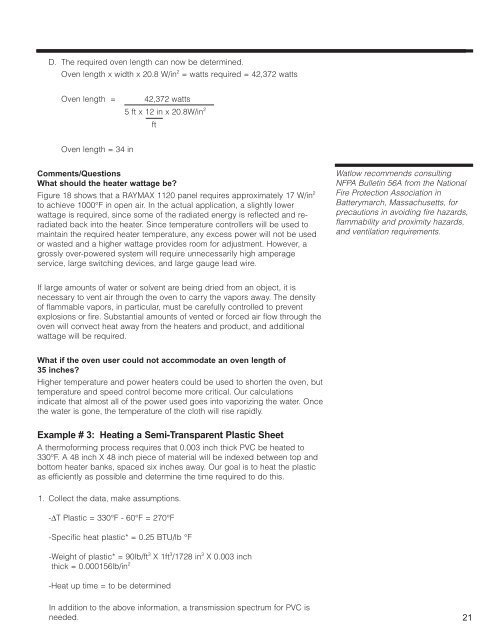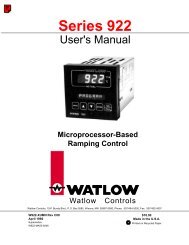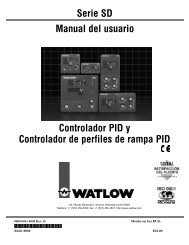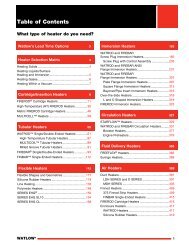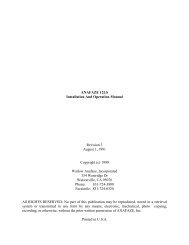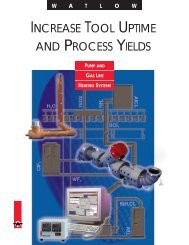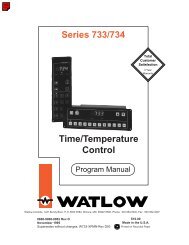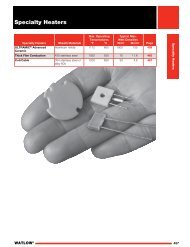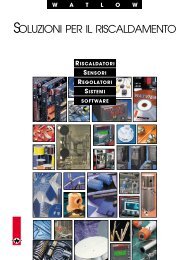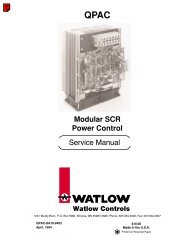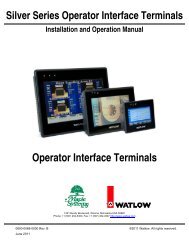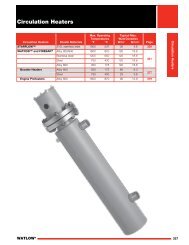RADIANT HEATING WITH INFRARED - Watlow
RADIANT HEATING WITH INFRARED - Watlow
RADIANT HEATING WITH INFRARED - Watlow
Create successful ePaper yourself
Turn your PDF publications into a flip-book with our unique Google optimized e-Paper software.
D. The required oven length can now be determined.<br />
Oven length x width x 20.8 W/in 2 = watts required = 42,372 watts<br />
Oven length = 42,372 watts<br />
Oven length = 34 in<br />
5 ft x 12 in x 20.8W/in 2<br />
ft<br />
Comments/Questions<br />
What should the heater wattage be?<br />
Figure 18 shows that a RAYMAX 1120 panel requires approximately 17 W/in 2<br />
to achieve 1000°F in open air. In the actual application, a slightly lower<br />
wattage is required, since some of the radiated energy is reflected and reradiated<br />
back into the heater. Since temperature controllers will be used to<br />
maintain the required heater temperature, any excess power will not be used<br />
or wasted and a higher wattage provides room for adjustment. However, a<br />
grossly over-powered system will require unnecessarily high amperage<br />
service, large switching devices, and large gauge lead wire.<br />
If large amounts of water or solvent are being dried from an object, it is<br />
necessary to vent air through the oven to carry the vapors away. The density<br />
of flammable vapors, in particular, must be carefully controlled to prevent<br />
explosions or fire. Substantial amounts of vented or forced air flow through the<br />
oven will convect heat away from the heaters and product, and additional<br />
wattage will be required.<br />
What if the oven user could not accommodate an oven length of<br />
35 inches?<br />
Higher temperature and power heaters could be used to shorten the oven, but<br />
temperature and speed control become more critical. Our calculations<br />
indicate that almost all of the power used goes into vaporizing the water. Once<br />
the water is gone, the temperature of the cloth will rise rapidly.<br />
Example # 3: Heating a Semi-Transparent Plastic Sheet<br />
A thermoforming process requires that 0.003 inch thick PVC be heated to<br />
330°F. A 48 inch X 48 inch piece of material will be indexed between top and<br />
bottom heater banks, spaced six inches away. Our goal is to heat the plastic<br />
as efficiently as possible and determine the time required to do this.<br />
1. Collect the data, make assumptions.<br />
-∆T Plastic = 330°F - 60°F = 270°F<br />
-Specific heat plastic* = 0.25 BTU/lb °F<br />
-Weight of plastic* = 90lb/ft 3 X 1ft 3 /1728 in 3 X 0.003 inch<br />
thick = 0.000156lb/in 2<br />
-Heat up time = to be determined<br />
In addition to the above information, a transmission spectrum for PVC is<br />
needed.<br />
<strong>Watlow</strong> recommends consulting<br />
NFPA Bulletin 56A from the National<br />
Fire Protection Association in<br />
Batterymarch, Massachusetts, for<br />
precautions in avoiding fire hazards,<br />
flammability and proximity hazards,<br />
and ventilation requirements.<br />
21


